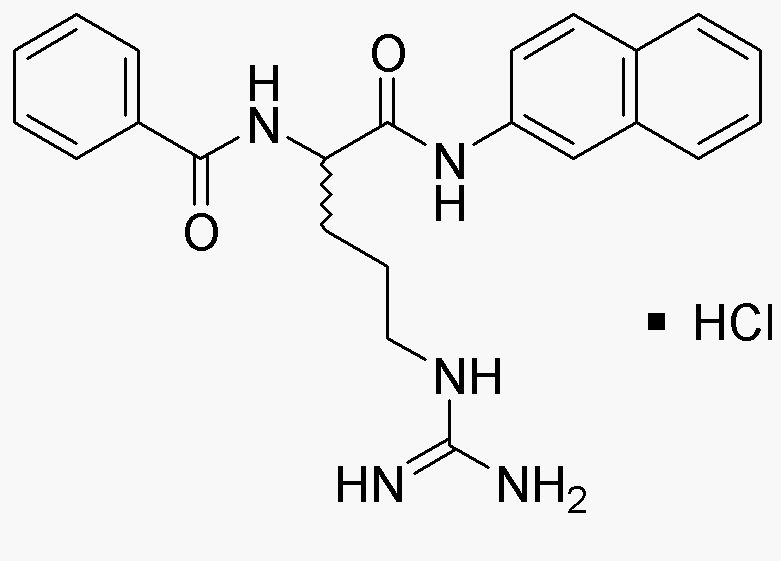Na-Benzoyl-DL-arginine b-naphthylamide hydrochloride is widely utilized in research focused on:
- Biochemical Research: This compound serves as a substrate in enzyme assays, particularly for studying proteases, allowing researchers to investigate enzyme kinetics and mechanisms.
- Pharmaceutical Development: It is used in drug formulation studies, especially in the development of peptide-based therapeutics, enhancing the understanding of drug interactions and efficacy.
- Cell Biology: The compound is applied in cell signaling studies, helping researchers explore cellular responses to various stimuli, which is crucial for understanding disease mechanisms.
- Diagnostic Applications: It can be utilized in the development of diagnostic assays, particularly in identifying specific protease activity in clinical samples, aiding in disease diagnosis.
- Material Science: This chemical is also explored in the synthesis of novel materials, leveraging its unique properties to create advanced polymers or composites with specific functionalities.
General Information
Properties
Safety and Regulations
Applications
Na-Benzoyl-DL-arginine b-naphthylamide hydrochloride is widely utilized in research focused on:
- Biochemical Research: This compound serves as a substrate in enzyme assays, particularly for studying proteases, allowing researchers to investigate enzyme kinetics and mechanisms.
- Pharmaceutical Development: It is used in drug formulation studies, especially in the development of peptide-based therapeutics, enhancing the understanding of drug interactions and efficacy.
- Cell Biology: The compound is applied in cell signaling studies, helping researchers explore cellular responses to various stimuli, which is crucial for understanding disease mechanisms.
- Diagnostic Applications: It can be utilized in the development of diagnostic assays, particularly in identifying specific protease activity in clinical samples, aiding in disease diagnosis.
- Material Science: This chemical is also explored in the synthesis of novel materials, leveraging its unique properties to create advanced polymers or composites with specific functionalities.
Documents
Safety Data Sheets (SDS)
The SDS provides comprehensive safety information on handling, storage, and disposal of the product.
Product Specification (PS)
The PS provides a comprehensive breakdown of the product’s properties, including chemical composition, physical state, purity, and storage requirements. It also details acceptable quality ranges and the product's intended applications.
Certificates of Analysis (COA)
Search for Certificates of Analysis (COA) by entering the products Lot Number. Lot and Batch Numbers can be found on a product’s label following the words ‘Lot’ or ‘Batch’.
*Catalog Number
*Lot Number
Certificates Of Origin (COO)
This COO confirms the country where the product was manufactured, and also details the materials and components used in it and whether it is derived from natural, synthetic, or other specific sources. This certificate may be required for customs, trade, and regulatory compliance.
*Catalog Number
*Lot Number
Safety Data Sheets (SDS)
The SDS provides comprehensive safety information on handling, storage, and disposal of the product.
DownloadProduct Specification (PS)
The PS provides a comprehensive breakdown of the product’s properties, including chemical composition, physical state, purity, and storage requirements. It also details acceptable quality ranges and the product's intended applications.
DownloadCertificates of Analysis (COA)
Search for Certificates of Analysis (COA) by entering the products Lot Number. Lot and Batch Numbers can be found on a product’s label following the words ‘Lot’ or ‘Batch’.
*Catalog Number
*Lot Number
Certificates Of Origin (COO)
This COO confirms the country where the product was manufactured, and also details the materials and components used in it and whether it is derived from natural, synthetic, or other specific sources. This certificate may be required for customs, trade, and regulatory compliance.


